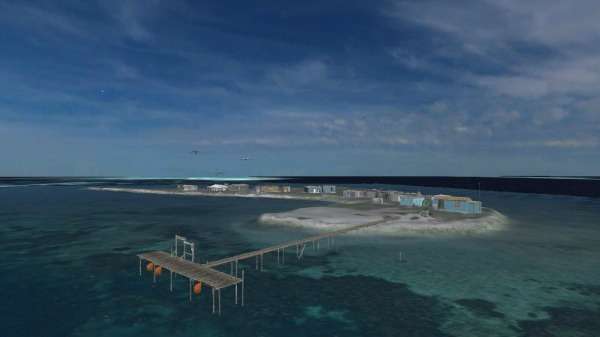An overview of Beacon Island from the Beacon Virtua simulation. Credit: UWA, Curtin HIVE, WA Museum.
Thanks to virtual reality (VR) technology, the public can experience and explore Beacon Island, the site of the notorious Batavia shipwreck
'Beacon Virtua' is a digital visualisation of Beacon island developed at the Curtin HIVE (Hub for Immersive Visualisation and eResearch) and The University of Western Australia (UWA) as part of an Australian Research Council (ARC) Linkage project led by UWA and the Western Australian Museum.
Part of the Houtman Abrolhos Islands near Geraldton, Western Australia, Beacon Island was home to fishing families from the 1960s and contained rudimentary shacks until 2015.
It is also the final resting place of around 200 travellers on the Dutch VOC ship Batavia who either perished following the sinking in 1629 or in the subsequent mutiny.
According to Dr Andrew Woods, Manager of the Curtin HIVE, Beacon Virtua is the first photo-accurate VR simulation of an Australian island.
"The simulation shows the island as it was in 2013 when it had a series of huts which supported an active crayfishing industry, but also exposes the dramatic history of Beacon Island – as it was the site of the shipwreck of the VOC ship Batavia in 1629 and contains many shallow graves," he says.
Users are able to view the island via a Google Cardboard 'App' that runs on a smartphone, using their phone as a head-mounted display – taking them to a virtual environment.
Dr Woods says Beacon Virtua combines a range of advanced visualisation technologies created using audio and photography captured during expeditions to the island.
"Complex 3-D objects were captured by taking a series of photographs around the object and processing them using a technique known as photogrammetric 3-D reconstruction," he says.
"Additionally over one hundred 360° photographic panorama bubbles were captured to allow a photo-accurate view to be seen at points right across the island."
The island is currently a difficult place to access, so Beacon Virtua provides an opportunity for people to have a virtual visit to the island allowing them to engage with the National Heritage sites.
"VR simulations are becoming more common, and allow people to be taken to wild and wonderful locations – some based on real-world locations, and others completely fictitious," Dr Wood says.
"There are lots of sites around WA which could use these techniques to reveal the natural and human-made wonders of our state to virtual visitors near and far."
Provided by Science Network WA
This article first appeared on ScienceNetwork Western Australia a science news website based at Scitech.























